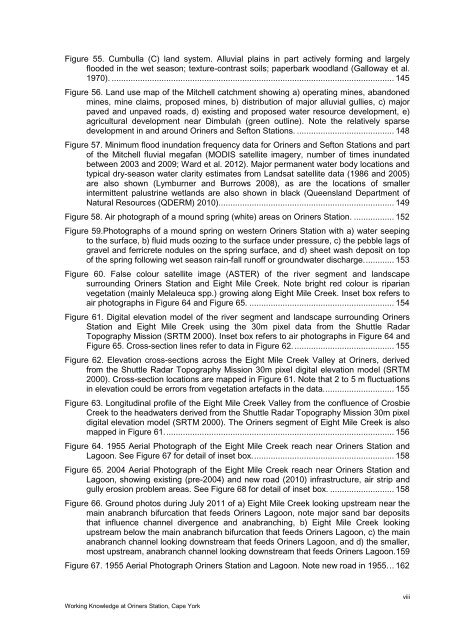WfHC - cover page (not to be used with pre-printed report ... - CSIRO
WfHC - cover page (not to be used with pre-printed report ... - CSIRO
WfHC - cover page (not to be used with pre-printed report ... - CSIRO
You also want an ePaper? Increase the reach of your titles
YUMPU automatically turns print PDFs into web optimized ePapers that Google loves.
Figure 55. Cumbulla (C) land system. Alluvial plains in part actively forming and largely<br />
flooded in the wet season; texture-contrast soils; paperbark woodland (Galloway et al.<br />
1970). ....................................................................................................................... 145<br />
Figure 56. Land use map of the Mitchell catchment showing a) operating mines, abandoned<br />
mines, mine claims, proposed mines, b) distribution of major alluvial gullies, c) major<br />
paved and unpaved roads, d) existing and proposed water resource development, e)<br />
agricultural development near Dimbulah (green outline). Note the relatively sparse<br />
development in and around Oriners and Sef<strong>to</strong>n Stations. ......................................... 148<br />
Figure 57. Minimum flood inundation frequency data for Oriners and Sef<strong>to</strong>n Stations and part<br />
of the Mitchell fluvial megafan (MODIS satellite imagery, num<strong>be</strong>r of times inundated<br />
<strong>be</strong>tween 2003 and 2009; Ward et al. 2012). Major permanent water body locations and<br />
typical dry-season water clarity estimates from Landsat satellite data (1986 and 2005)<br />
are also shown (Lymburner and Burrows 2008), as are the locations of smaller<br />
intermittent palustrine wetlands are also shown in black (Queensland Department of<br />
Natural Resources (QDERM) 2010).......................................................................... 149<br />
Figure 58. Air pho<strong>to</strong>graph of a mound spring (white) areas on Oriners Station. ................. 152<br />
Figure 59.Pho<strong>to</strong>graphs of a mound spring on western Oriners Station <strong>with</strong> a) water seeping<br />
<strong>to</strong> the surface, b) fluid muds oozing <strong>to</strong> the surface under <strong>pre</strong>ssure, c) the pebble lags of<br />
gravel and ferricrete nodules on the spring surface, and d) sheet wash deposit on <strong>to</strong>p<br />
of the spring following wet season rain-fall runoff or groundwater discharge. ............ 153<br />
Figure 60. False colour satellite image (ASTER) of the river segment and landscape<br />
surrounding Oriners Station and Eight Mile Creek. Note bright red colour is riparian<br />
vegetation (mainly Melaleuca spp.) growing along Eight Mile Creek. Inset box refers <strong>to</strong><br />
air pho<strong>to</strong>graphs in Figure 64 and Figure 65. ............................................................. 154<br />
Figure 61. Digital elevation model of the river segment and landscape surrounding Oriners<br />
Station and Eight Mile Creek using the 30m pixel data from the Shuttle Radar<br />
Topography Mission (SRTM 2000). Inset box refers <strong>to</strong> air pho<strong>to</strong>graphs in Figure 64 and<br />
Figure 65. Cross-section lines refer <strong>to</strong> data in Figure 62. .......................................... 155<br />
Figure 62. Elevation cross-sections across the Eight Mile Creek Valley at Oriners, derived<br />
from the Shuttle Radar Topography Mission 30m pixel digital elevation model (SRTM<br />
2000). Cross-section locations are mapped in Figure 61. Note that 2 <strong>to</strong> 5 m fluctuations<br />
in elevation could <strong>be</strong> errors from vegetation artefacts in the data. ............................. 155<br />
Figure 63. Longitudinal profile of the Eight Mile Creek Valley from the confluence of Crosbie<br />
Creek <strong>to</strong> the headwaters derived from the Shuttle Radar Topography Mission 30m pixel<br />
digital elevation model (SRTM 2000). The Oriners segment of Eight Mile Creek is also<br />
mapped in Figure 61. ................................................................................................ 156<br />
Figure 64. 1955 Aerial Pho<strong>to</strong>graph of the Eight Mile Creek reach near Oriners Station and<br />
Lagoon. See Figure 67 for detail of inset box. ........................................................... 158<br />
Figure 65. 2004 Aerial Pho<strong>to</strong>graph of the Eight Mile Creek reach near Oriners Station and<br />
Lagoon, showing existing (<strong>pre</strong>-2004) and new road (2010) infrastructure, air strip and<br />
gully erosion problem areas. See Figure 68 for detail of inset box. ........................... 158<br />
Figure 66. Ground pho<strong>to</strong>s during July 2011 of a) Eight Mile Creek looking upstream near the<br />
main anabranch bifurcation that feeds Oriners Lagoon, <strong>not</strong>e major sand bar deposits<br />
that influence channel divergence and anabranching, b) Eight Mile Creek looking<br />
upstream <strong>be</strong>low the main anabranch bifurcation that feeds Oriners Lagoon, c) the main<br />
anabranch channel looking downstream that feeds Oriners Lagoon, and d) the smaller,<br />
most upstream, anabranch channel looking downstream that feeds Oriners Lagoon.159<br />
Figure 67. 1955 Aerial Pho<strong>to</strong>graph Oriners Station and Lagoon. Note new road in 1955. .. 162<br />
Working Knowledge at Oriners Station, Cape York<br />
viii
















